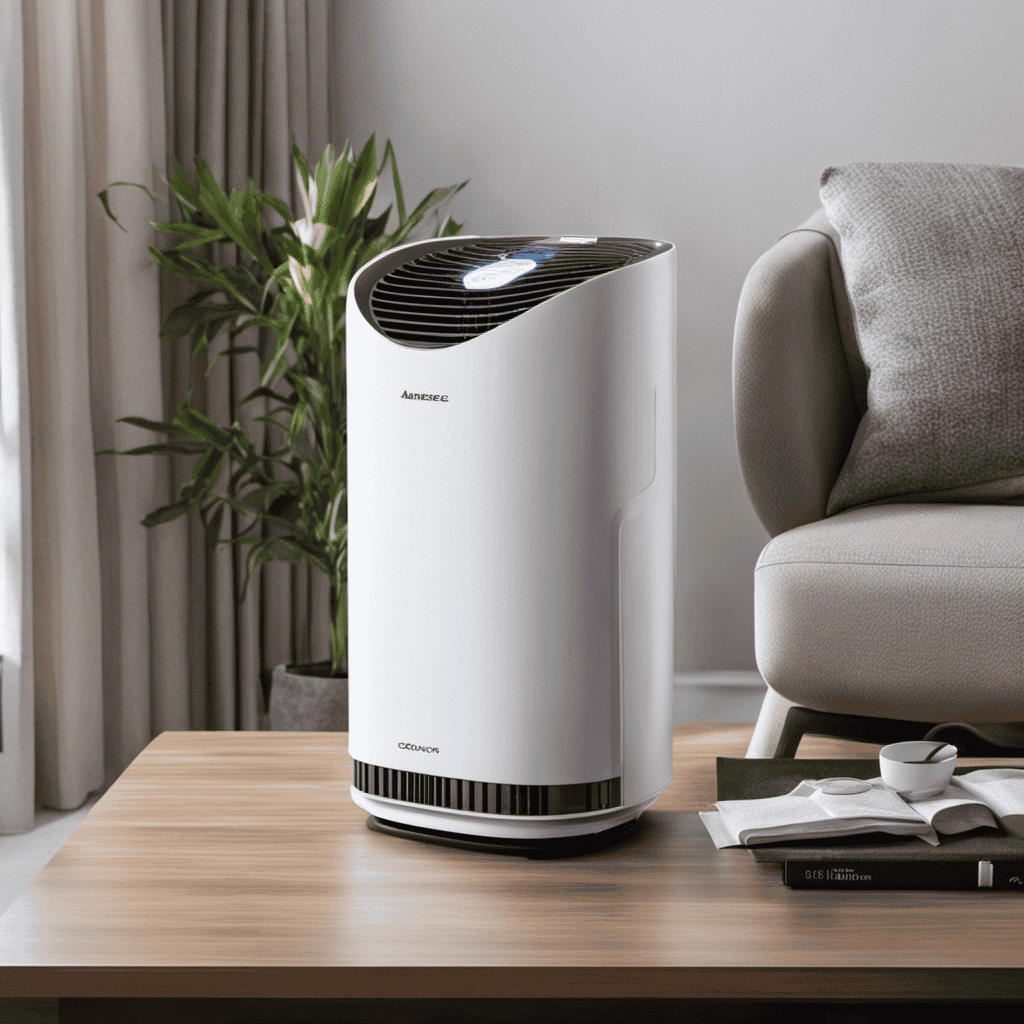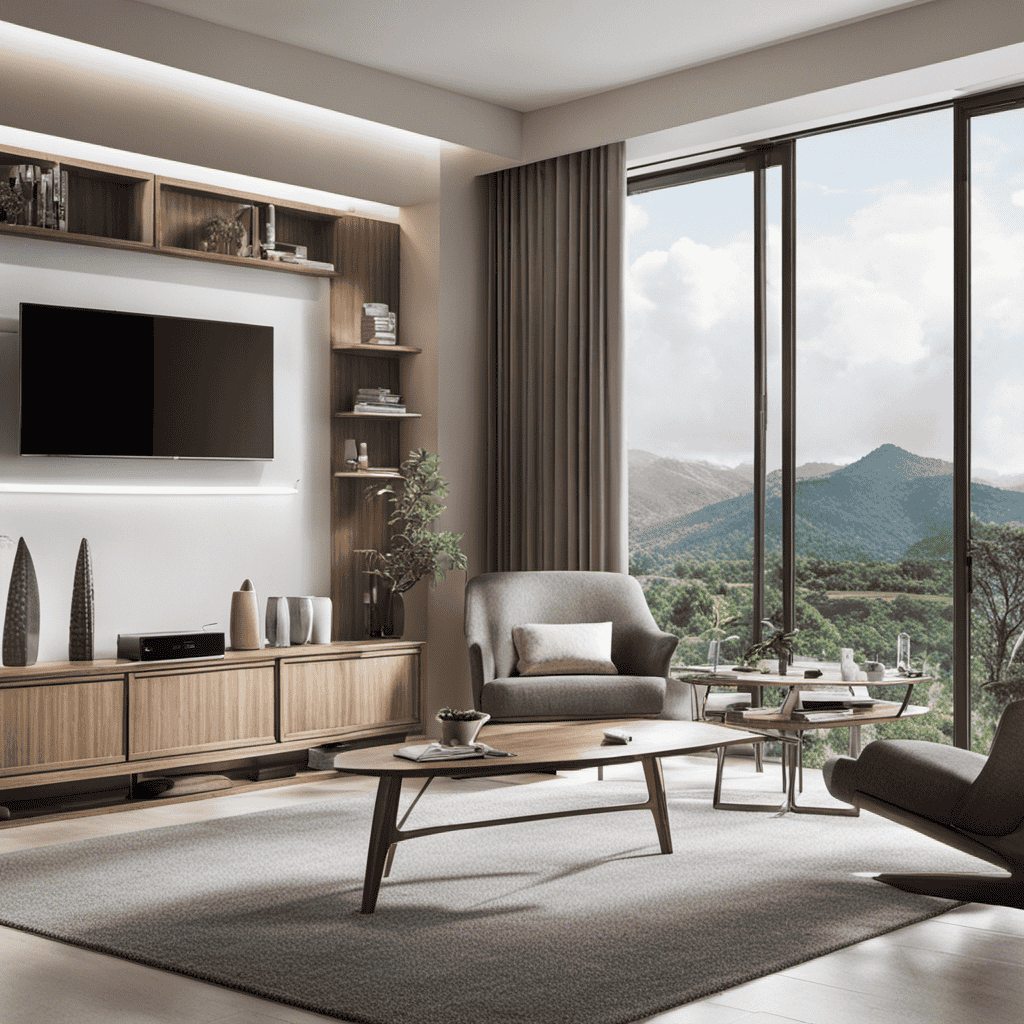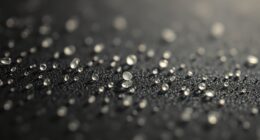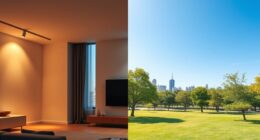I have found the ultimate air purification solution: UV light. This potent light not only eradicates germs and bacteria, but also fights odors and eradicates mold and fungi. It even effectively tackles allergens and viruses.
In this article, I’ll delve into the fascinating world of UV light and explore how it works in air purifiers. Get ready to unlock the full potential of your air purifier and breathe cleaner, fresher air than ever before.
Key Takeaways
- UV light in air purifiers neutralizes harmful bacteria and viruses by disrupting their DNA and preventing them from reproducing.
- UV light improves indoor air quality by eliminating airborne particles and reducing the presence of allergens.
- UV light technology can be combined with other filtration methods for better results in air purification.
- Prolonged exposure to UV light can cause skin burns and eye damage, so it is important to ensure air purifiers have built-in safety mechanisms and to avoid direct exposure.
Understanding UV Light
To understand UV light, you need to know that it is a technology used in air purifiers to neutralize harmful bacteria and viruses. UV, or ultraviolet, light falls in the electromagnetic spectrum between visible light and X-rays. It is divided into three categories: UV-A, UV-B, and UV-C.
UV-C light, with a wavelength of 200-280 nanometers, is the most effective for air purification. When UV-C light is emitted from the air purifier, it penetrates the DNA of microorganisms, disrupting their genetic material and preventing them from reproducing.
However, it is important to note that UV-C light can be harmful to humans if exposed for long periods. Therefore, safety precautions should be taken when using UV light in air purifiers, such as covering the light source and ensuring it is not directly exposed to the eyes or skin.
How UV Light Works in Air Purifiers
UV light in air purifiers works by destroying harmful microorganisms in the air. Understanding UV radiation and its effects on air pollution is crucial in comprehending how this process works.
UV light is a type of electromagnetic radiation that falls within the spectrum of wavelengths shorter than visible light. When UV light is emitted from the air purifier, it penetrates the cell walls of microorganisms, such as bacteria, viruses, and mold spores. This radiation damages the DNA or RNA within these microorganisms, preventing them from reproducing and rendering them inactive.
As a result, the air becomes cleaner and safer to breathe. UV light in air purifiers is an effective method for eliminating these harmful microorganisms and improving indoor air quality.
Benefits of UV Light in Air Purification
UV light in air purifiers offers several key benefits in terms of air purification.
Firstly, it effectively kills harmful bacteria that may be present in the air, helping to create a healthier and safer environment.
Secondly, it reduces allergens by targeting and neutralizing them, providing relief to individuals who suffer from allergies or respiratory conditions.
Lastly, the use of UV light enhances overall air quality by eliminating airborne particles and improving the overall freshness and cleanliness of the air we breathe.
Kills Harmful Bacteria
You can easily see how harmful bacteria are eliminated by the UV light in an air purifier. UV light, specifically in the UV-C wavelength range, has the ability to disrupt the DNA of bacteria, ultimately killing them. This process is highly effective in reducing the presence of harmful bacteria in the air, making it safer and healthier to breathe.
Here are some key points to consider:
- UV light works by damaging the DNA structure of bacteria, preventing them from replicating and causing harm.
- The intensity and exposure time of the UV light determine its effectiveness in killing bacteria.
- Air purifiers with UV light technology can target bacteria and other microorganisms present in the air.
- The combination of UV light and other filtration methods, such as HEPA filters, can further enhance the overall effectiveness in reducing allergens effectively.
Reduces Allergens Effectively
Combining UV light technology with other filtration methods, such as HEPA filters, can effectively reduce the presence of allergens in the air. UV light works by destroying the DNA and RNA of microorganisms, including allergens like dust mites, mold spores, and pollen. When these microorganisms are exposed to UV light, their ability to reproduce and cause allergy symptoms is greatly diminished. This is crucial for reducing respiratory irritants and preventing asthma attacks.
UV light is particularly effective in eliminating mold spores, which are a common trigger for asthma and allergies. By targeting the DNA of mold spores, UV light prevents them from reproducing and spreading throughout the air. When combined with HEPA filters, which trap and remove larger particles like dust and pollen, UV light technology provides a comprehensive solution for reducing allergens and improving indoor air quality.
Enhances Overall Air Quality
When used in conjunction with HEPA filters, the combination of UV light technology significantly improves the overall quality of the air you breathe. UV light works by targeting and destroying harmful microorganisms, such as bacteria, viruses, and mold spores, that can be present in the air. This not only enhances air circulation but also improves respiratory health.
Here are four key ways in which UV light technology enhances overall air quality:
-
Destroys airborne pathogens: UV light has the ability to penetrate the cellular structure of microorganisms, rendering them inactive and unable to reproduce.
-
Reduces allergens: UV light helps to eliminate common allergens like dust mites and pollen, providing relief for those with allergies or asthma.
-
Eliminates odors: UV light technology can break down volatile organic compounds (VOCs) that cause unpleasant odors in the air.
-
Prevents mold growth: UV light inhibits the growth of mold by disrupting its DNA, preventing it from spreading and causing respiratory issues.
UV Light and the Elimination of Germs and Bacteria
When it comes to UV light sterilization effectiveness, it’s important to understand that this technology has been proven to be highly effective in killing germs and bacteria.
UV light works by disrupting the DNA of microorganisms, preventing them from replicating and causing harm.
This makes it an invaluable tool in maintaining a healthy and germ-free environment.
UV Light Sterilization Effectiveness
To gauge the effectiveness of UV light sterilization in an air purifier, you can consider the percentage of germs and bacteria that are successfully eliminated. UV light has been proven to be highly effective in killing harmful microorganisms, making it an essential feature in air purifiers.
When it comes to UV light safety, it’s important to note that modern air purifiers are designed with safety measures in place to prevent direct UV light exposure. Here are some key points to consider:
- The UV light in air purifiers is contained within a sealed chamber, preventing any direct contact with humans.
- The air purifier’s UV light is shielded by a quartz sleeve, ensuring optimal performance while minimizing any potential exposure.
- Air purifiers equipped with UV light often come with safety certifications, indicating that they adhere to industry standards.
- Regular maintenance, such as replacing the UV bulb as recommended by the manufacturer, ensures continued effectiveness and safety.
Now, let’s explore the health benefits of UV in air purifiers.
Health Benefits of UV
You can experience improved indoor air quality by utilizing UV technology in your air purifier. UV light is highly effective at killing and neutralizing harmful bacteria, viruses, and other microorganisms that may be present in the air. This is especially beneficial for individuals with respiratory issues or weakened immune systems, as it helps to reduce the risk of infections and illnesses caused by airborne pathogens.
UV light is also effective at neutralizing odors and reducing the presence of allergens in the air, such as pet dander, pollen, and dust mites. By incorporating UV technology into your air purifier, you can enjoy cleaner, fresher air while also reaping the health benefits of improved indoor air quality.
UV Light’s Role in Neutralizing Odors
Using UV light in your air purifier helps neutralize odors in your home. This powerful technology efficiently eliminates unwanted scents, particularly those caused by pets. Here’s how it works:
-
UV-C light: The air purifier emits UV-C light, which breaks down the molecular structure of odor-causing particles, rendering them harmless.
-
Eliminating pet odors: UV light targets the volatile organic compounds (VOCs) produced by pets, such as ammonia and sulfur compounds. These compounds are responsible for the unpleasant smell.
-
Sterilizing effect: UV light also acts as a germicidal agent, killing bacteria and viruses that can contribute to odors.
-
Long-lasting freshness: By neutralizing scents at the molecular level, the air purifier ensures that your home remains odor-free for extended periods.
With UV light in your air purifier, you can enjoy a clean and fresh-smelling home, free from pet odors and other unwanted scents.
UV Light and the Removal of Mold and Fungi
The presence of UV light in your air purifier aids in eliminating mold and fungi. UV light works by disrupting the DNA of these microorganisms, preventing them from replicating and causing further damage. This is an effective method for mold prevention and air purification, as it targets the source of the problem rather than simply masking the odor or symptoms. UV light can be used in conjunction with other filtration methods to maximize the removal of mold and fungi from the air.
To illustrate the effectiveness of UV light in eliminating mold and fungi, consider the following table:
| UV Light Exposure | Effect on Mold and Fungi |
|---|---|
| High | Complete elimination |
| Medium | Significant reduction |
| Low | Partial reduction |
As shown in the table, higher levels of UV light exposure result in complete elimination of mold and fungi, while lower levels still offer some reduction. It is important to note that regular maintenance and cleaning of the air purifier is necessary to ensure optimal performance and continued mold prevention.
UV Light’s Impact on Allergens and Viruses
UV light’s impact on allergens and viruses can be significant, as it disrupts their DNA and prevents them from spreading. This makes it an effective tool in improving respiratory health and reducing the risk of allergies and infections. Here are some key points to consider:
- UV light is highly effective in neutralizing allergens such as pollen, dust mites, and pet dander, which can trigger respiratory issues and allergies.
- It also targets and destroys viruses, including the flu virus and common cold viruses, reducing the chances of getting sick.
- UV light in air purifiers works by emitting short wavelength ultraviolet-C (UVC) light, which damages the genetic material of these microorganisms, rendering them inactive.
- Unlike chemical disinfectants, UV light is a natural and chemical-free method that does not leave any residual substances in the air.
Considering the impact of UV light on allergens and viruses, it is crucial to understand the considerations when using it in air purifiers.
Considerations When Using UV Light in Air Purifiers
When considering UV light in air purifiers, it’s important to be aware of potential safety risks. UV light can be effective in killing germs and bacteria, but it can also be harmful to humans if not used properly. Here are some important considerations for UV light safety in air purifiers:
| Safety Consideration | Description | Recommendations |
|---|---|---|
| UV Exposure | Prolonged exposure to UV light can cause skin burns and eye damage. | Ensure that the air purifier has built-in safety mechanisms such as automatic shut-off when the device is opened. Also, avoid direct exposure to UV light and use protective eyewear when necessary. |
| Ozone Production | Some air purifiers with UV light can produce ozone, which can be harmful to respiratory health. | Choose air purifiers that are ozone-free or have low ozone emission levels. Check the product specifications and look for certifications such as the California Air Resources Board (CARB) compliance. |
| Maintenance | Regular maintenance is crucial to ensure the effectiveness and safety of UV light in air purifiers. | Follow the manufacturer’s guidelines for filter replacement and cleaning. Keep the device clean and free from dust and debris buildup. |
Frequently Asked Questions
How Long Does UV Light Need to Be Exposed to Air in Order to Effectively Kill Germs and Bacteria in an Air Purifier?
To effectively kill germs and bacteria in an air purifier, UV light needs to be exposed to the air for a sufficient amount of time. This exposure time is crucial for the elimination of harmful pathogens and improving overall air quality.
Can UV Light in an Air Purifier Eliminate All Types of Odors, Including Strong and Persistent Ones?
Yes, UV light in an air purifier can eliminate strong and persistent odors. However, its effectiveness may vary depending on the specific odor and the exposure time. There are limitations to consider.
Does UV Light in an Air Purifier Have Any Negative Effects on the Quality of the Air Being Purified?
The effectiveness of UV light in an air purifier is not compromised by any negative effects on the quality of the air being purified. UV light efficiently eliminates contaminants without causing any harm.
Are There Any Specific Safety Precautions or Guidelines to Follow When Using an Air Purifier With UV Light?
When using an air purifier with UV light, it is important to follow safety precautions and guidelines. Ensure effective exposure time for odor elimination without negative effects, and consider its role in reducing airborne virus spread.
Can the Use of UV Light in an Air Purifier Help Reduce the Spread of Airborne Viruses, Such as the Flu or Covid-19?
Yes, UV light in an air purifier can help reduce the spread of airborne viruses like the flu or COVID-19. Its effectiveness is limited to the air that passes through the purifier and may not reach all areas.
Conclusion
In conclusion, the utilization of UV light in air purifiers is an effective and powerful method to enhance the purification process.
By harnessing the energy of UV light, air purifiers are able to neutralize germs, bacteria, molds, fungi, allergens, and even viruses.
This technology not only eliminates harmful pathogens but also eliminates unwanted odors, leaving the air fresh and clean.
When considering an air purifier, it is crucial to prioritize models that incorporate UV light for maximum efficiency and protection.










